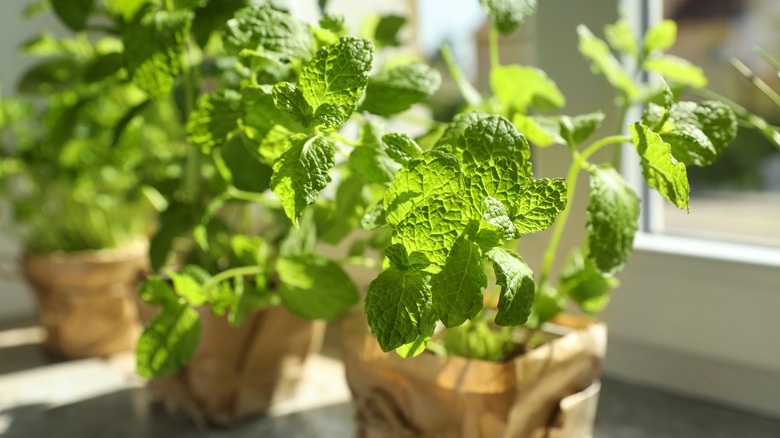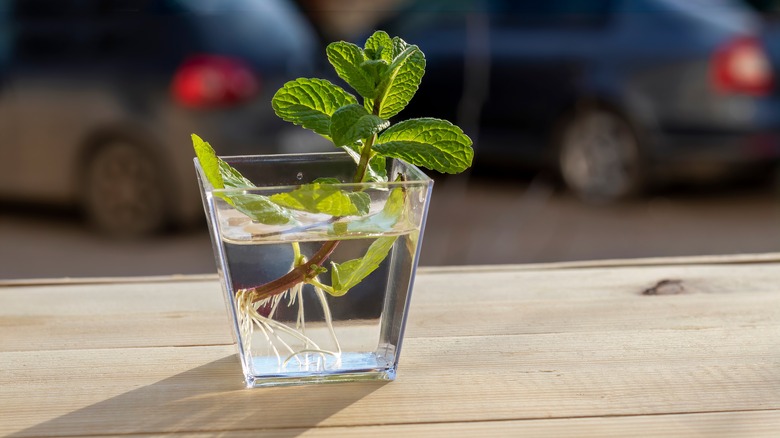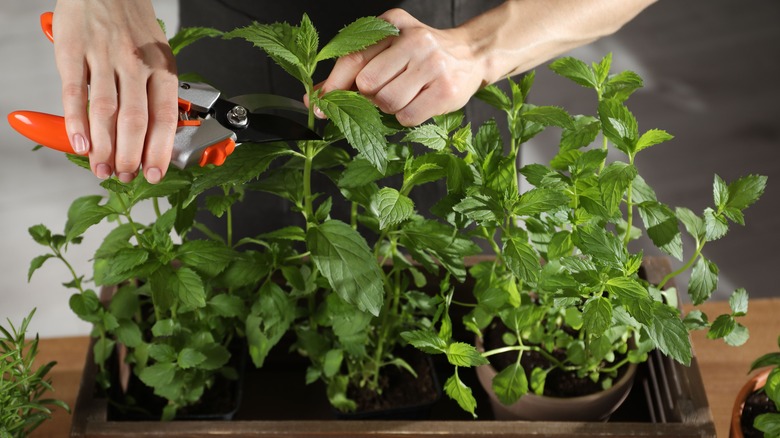The Best Way To Grow Mint Indoors For An Endless Supply Of Fresh Herbs
Having an endless supply of fresh mint to add to your cooking is not that difficult, as the herb can easily be grown indoors. Mint grows extremely well in pots — which is great news because it can be quite invasive when grown in the garden. All you need to grow mint indoors is a sunny windowsill, a nice pot with plenty of drainage holes, and some premium potting mix. In fact, you should keep this tasty herb in the house to help ward off cockroaches and repel spiders.
Mint can grow in direct sunlight but will also thrive if you just expose it to some indirect sunlight when growing it indoors. Ideally, you want to grow your mint on a south-facing window, but an east or west-facing window will suffice. One important tip that you'll want to remember is to rotate the pot often so that all sides of the plant are exposed to some sunlight regularly. Move the plant out of direct sunlight if the leaves start getting crispy. There are hundreds of different varieties of mint that you can grow indoors, and these can provide some excellent additions to your cooking, baking, and mixology. For example, while peppermint and spearmint are fairly popular plants, you might like to try some of the more unusual varieties such as apple mint or chocolate mint.
Planting your mint in a container
Mint can easily be grown from seeds, cuttings or even runners. Or you can purchase a seedling or plant from your local nursery, garden center, or supermarket and propagate it at home. Seeds can be sown straight into your chosen pot that you've filled with premium potting soil. The seeds should only take around 10 to 14 days to germinate. You can grow mint plants from cuttings by rooting them in water and then transplanting into soil once enough roots have formed. You can also remove some runners for an existing plant that have root nodules on them and plant these straight into your pot.
Once planted, place your pot on a nice sunny windowsill in the kitchen — only if that's practical for your kitchen layout, of course. Growing your mint in the kitchen is ideal because it means the mint will be handy when you want to cut off a few sprigs to add to your cooking, desserts, or drinks. But obviously mint doesn't care about which room in the house it grows in, just that it's the right temperature and humidity. You'll find that the kitchen is nice and warm, perfect for cultivating mint, although mint plants can actually survive in temperatures as low as minus 20 degrees Fahrenheit. Mint prefers to grow in temperatures ranging from 60 to 70 degrees Fahrenheit — so keep it away from heaters or vents.
Caring for your mint plant
Mint is easy to grow and doesn't require a lot of maintenance. It does prefer moderate watering so that the soil doesn't dry out completely. But you want to ensure that the excess water can drain away freely so that your plant doesn't have wet roots constantly — that's a mistake that could lead to root rot. One thing that you do want to do is trim your mint regularly as it starts to grow. Tip pruning is ideal to create a nice bushy plant that will stay relatively compact. To tip prune your plant, just pinch off the tips with your thumb and forefinger. Or you can use kitchen scissors or secateurs to give your mint a haircut.
Although herbs like mint don't require a lot of fertilizer, because you're growing it in a pot, any nutrients in the potting soil will eventually be depleted. Therefore, you can either use a slow-release fertilizer that you apply once in spring or use a diluted mixture of liquid feed when you water your plant. Dilute the liquid feed to half strength, and only apply this around once a month during the warmer growing season. Mint shouldn't be too difficult to keep alive, since it's one of the easiest herbs to grow indoors, ideal for novice gardeners and home chefs.


